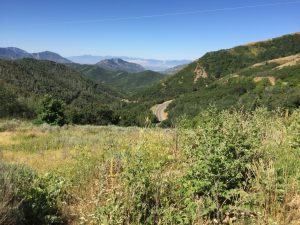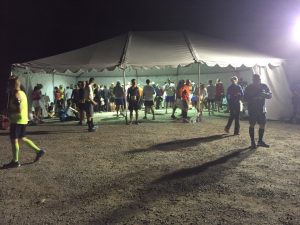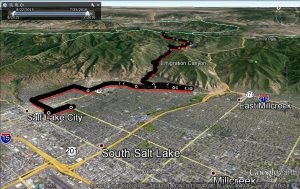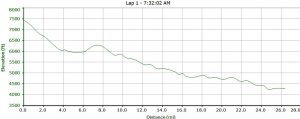OK – the first thing you have to be wondering is “What the heck is Pie and Beer Day?” Having lived many years ago in Salt Lake City, Utah, I always found the celebration of “Pioneer Day” on July 24 a rather curious holiday which pushes the notion of separation of church and state almost as hard as Christmas. It is a state holiday in Utah, celebrating the arrival of Brigham Young and the rest of the Mormons into the Salt Lake Valley on that day in 1847, and as a result made for a curious day off for those of us who lived there and did not follow that faith. Apparently, a few years ago, a tradition arose among the heathens (also curiously known as “gentiles”) of Salt Lake, celebrating the parallel holiday of “Pie and Beer Day” , which is generally interpreted to involve drinking beer (3.2 beer of course, as it is Utah) and eating pizza, instead of sitting in the hot sun watching a parade and eating lots of green jello salads. It sounds like a good counter-culture holiday to me!
That said, the official reason for my arrival in Salt Lake was to run the Deseret News Classic Marathon, a road marathon through the mountains following the course of Brigham Young’s arrival into Salt Lake. So, while this was a road race for most of its length, it was on lightly-traveled roads in some very scenic mountains, and as such, it was a road race attractive to a Vermont runner accustomed to mountain trails. This Pioneer Day race is usually held on July 24, but since that fell on a Sunday this year, the holiday celebration was postponed to Monday, July 25 so as not to conflict with traditional Sunday activities.
Since I probably wasn’t going to be taking many pictures during the course of the actual race, I scouted out the course on the day before in order to get a few shots for this blog, as well as to visit some roads I had not seen since the mid-1980’s when I used to bicycle up and down these passes after work. The start of the race is at Big Mountain Pass, the point where the Mormon Pioneers got their first glimpse of the valley of the Great Salt Lake. Of course, the view is equally intimidating to a runner, who can see how far away he or she has to go!

While standing at the summit of the pass, I spied a historic marker I had never seen before. As it turns out, the Mormons were not the first to use this pass. That “honor” fell on the ill-fated 1846 Donner Party, attempting to follow the poorly described “Hastings Cutoff” on their way to California. The Donner Party took two weeks to cover the terrain from the top of Big Mountain Pass to the Salt Lake valley, constructing a makeshift road as they went, and this delay added to their delay in reaching the Sierras in time to beat the winter snows, and the rest, as they say, is history.
On the actual morning of the race, the view was quite different from the above picture, for obvious reasons when one considers the big challenges to the marathon – heat, height, and humidity (as in lack of). While the race started high in the cool mountains at around 7400′, it finished in the searing mid-summer valley heat. In fact, on the day of the race, the weather report called for 102 degree afternoon temperatures – clearly unfit for running. So, the race started at 5:30 am, ensuring that the temperature at the finish line would “only” be in the 80’s for all but the slowest runners. The view was considerably different when we arrived at the start line at 4:30 am – dark, except for a well-lit area for the runners, and the glow of the city in the distance. And like almost every race I have ever attended, there were not enough portapotties at the start. So, it was dark, and being ever-chivalrous, allowing the female competitors to have first dibs at the limited resources, I headed for the dark woods to relieve my pre-race hydration issues. As I was quietly doing my business in the shelter of a few aspens, I suddenly found myself in a spotlight, and heard over a bullhorn “Please use the porta-potties”. Ok – I got busted by the Salt Lake City water authority police, who were so concerned about the urination of a mere 300 hundred runners shivering atop a mountain pass 26.2 miles out of town, that they actually sent an officer on urine patrol! I laughed it off….and shouted back “Busted – too late” and stepped back into the crowds, hearing laughter and mild applause from the few runners who caught my little drama. But, I didn’t hear another bullhorn, so either the crowd was cowed enough to follow the rules, or perhaps the watershed authorities decided they had better things to do than to monitor the bladders of well-hydrated runners.

By the time that the starting gun went off, it was barely bright enough to see, but I saw no sign that any of the 300+ runners fell off any cliffs on the tight, steep switchbacks at the top of the pass. I have done long races with long descents before, but this one was particularly hard on the legs, dropping 1500 ft in the first 4 miles, with no opportunity to warm up. I knew I would be paying for this later in the race no matter how fast I ran it, and I was correct. Within a few minutes, the glow of the sun illuminated the road, and the next challenge of the day presented itself, the only climb on the course, a short ascent to the top of Emigration Canyon, which then led directly into the city. This climb was only 350 ft, between miles 6 and 8, but the altitude was high enough to get me a little more winded than I usually would be on a modest climb like this. However, reaching the top of this second pass, I knew it would be all downhill from there until the last few miles on the valley floor a few hours later. The next 8 miles descending Emigration Canyon went very quickly, as well they should – the middle third of any marathon is usually the fastest part, and the long gradual descent made the miles go by even faster. I could start feeling my legs tightening at around mile 10, however, paying the price for the early steep descent, and I knew that this would be an issue as I approached the finish line.
At about mile 16, the race entered the benches on the hillsides of Salt Lake City proper, and the sun started to arise above the mountainsides. I also started looking at my watch more seriously, as the race organizers had mentioned that all runners who reached mile 24 at 9 am would be allowed to run along the downtown Pioneer Day parade route, and those who arrived later would be routed down an alternative route. Pushing as hard as I could as my legs got tighter and tighter, I passed the cutoff point with 4 minutes to spare, and had the pleasure of running past tens of thousands of folks out there for the holiday festivities, before finishing in Liberty Park – a location only a few blocks away from where I lived when I worked at the U. of Utah! My legs definitely felt the agony of the long descent in these last two miles however, as I was forced to walk much of it.
All in all, this was a fun mountain race. While the marathon was modest in scope, I was impressed by the fact that the organizers managed to pull off a marathon, half marathon, 10K and 5K race simultaneously, making this a much bigger event than just a mere marathon, with thousands of runners participating more or less concurrently. And as I limped back to my hotel room, after a shower and nap, I feasted on pie and beer!

